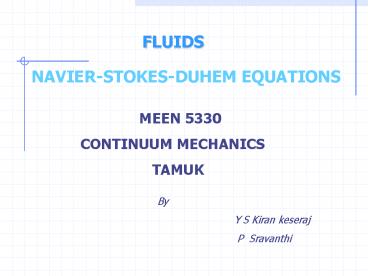FLUIDS PowerPoint PPT Presentation
1 / 18
Title: FLUIDS
1
FLUIDS
NAVIER-STOKES-DUHEM EQUATIONS
MEEN 5330 CONTINUUM MECHANICS
TAMUK
By Y S Kiran keseraj
P Sravanthi
2
PRESENTATION OUTLINE
- Basic Definitions Of Fluids
- Basic Equations Of Fluids
- Constitutive equations of Fluids
- Basic Assumptions Of Fluids
- Derivation of Navier-Stokes-Duhem Equation
- Applications
- Example problem
- Homework Problem
- References
3
BASIC DEFINITIONS OF FLUIDS
- Stress
- It is the internal distribution of forces
within a body - that balance and react to loads applied to
it. - Strain
- Strain is defined as the elongation of
an element - with respect to its original length.
- Newtanian Fluid
- It is a fluid in which shear stress
is linearly proportional - to the velocity gradient in the direction
perpendicular to - the plane of shear.
4
BASIC DEFINITIONS OF FLUIDS (Contd)
- Linear Momentum
- It is the tendency of an object moving in a
certain - direction to keep going at the same speed in
the same - direction.
- Angular Momentum
- It is the product of the momentum of a
rotating - body and its distance from the axis of
rotation. - Shear Modulus
- It is defined as the ratio of shear stress
to the - shear strain.
5
BASIC EQUATIONS
- Conservation of linear momentum
- Conservation of Angular Momentum
- Conservation of Mass(Continuity Equation)
Velocity gradient
Density
Stress Tensor
6
CONSTITUTIVE EQUATIONS OF FLUIDS
Constitutive equation is a relation between
two physical quantities (often tensors) that is
specific to a material or Substance and not
follow directly from physical law.
7
BASIC ASSUMPTIONS OF FLUIDS
- Fluid should be continuous.
- Should not contain any voids formed.
- Fields like pressure, temperature, velocity,
- density etc., are differentiable
8
DERIVATION OF NAVIER-STOKES-DUHEM
EQUATION
The Navier-Stokes equations are the
fundamental partial differentials equations that
describe the flow of incompressible fluids.
Two of the alternative forms of equations of
motion, using the Eulerian description, were
given as Equation (1) and Equation (2)
respectively
(1)
(2)
9
DERIVATION
(Contd)
If we assume that the fluid is isotropic ,
homogeneous , and Newtonian, then
(3)
Substituting Equ(3) into Equ(2), and utilizing
the Eulerian relationship for linear stress
tensor we get
(4)
( for compressible fluids )
10
DERIVATION
(Contd)
For incompressible fluid flow the
Navier-Stokes- Duhem equation is
If the fluid medium is a monatomic ideal gas,
then
11
DERIVATION
(Contd)
Navier stokes equation for compressible flow of
monatomic ideal gas is
12
APPLICATIONS
- Navier-Stokes equations are useful in
describing - the flow of fluids like liquids and gases.
- They are applied in wide range of practical
problems. - Navier-Stokes equations are sufficiently
accurate for - cases where fluid flow is laminar.
13
EXAMPLE PROBLEM
Neglecting the gravity field, describe the steady
two- dimensional flow of an isotropic ,
homogeneous, Newtonian fluid due to a constant
pressure gradient between two infinite, flat,
parallel, plates. State the necessary
assumptions. Assume that the fluid has a uniform
density.
14
SOLUTION
(Contd)
The Naveir stokes equations for incompressible
flow is
Since the flow is steady and the body forces are
neglected, the Navier-stokes equation becomes
15
SOLUTION
(Contd)
The no slip boundary conditions for viscous flow
are
at
Using the boundary conditions ( q2 0 at y2/- a
) Thus, the first Naveir-stokes equations becomes
16
SOLUTION
(Contd)
Integrating twice, we obtain
The results, assumptions and boundary conditions
of this problem in terms of, mathematical symbols
are as follows
Constant
17
HOMEWORK PROBLEM
If a fluid motion is very slow so that higher
order terms in the velocity are negligible, a
limiting case known as creeping flow results .
For this case show that in a steady
incompressible flow with zero body forces the
pressure is a harmonic function, i.e. .
where p is the Pressure.
18
REFERENCES
- http//scipp.ucsc.edu/haber/ph171/part11.pdf
- http//www.navier-stokes.net/nscr.html
- http//www.math.odu.edu/jhh/part11.pdf
- www.math.tu.berlin.de/slawig/research/control-fen
lab/paper - www.answers.com
- http//navier-stokes-equations.search.ipupdater.co
m/ - Frederick ,D and Chang, T.S , Continuum
Mechanics , Scientific Publishers, Inc.,
Cambridge, 1972. - George E. Mase , Continuum Mechanics ,
Schaums Outlines

